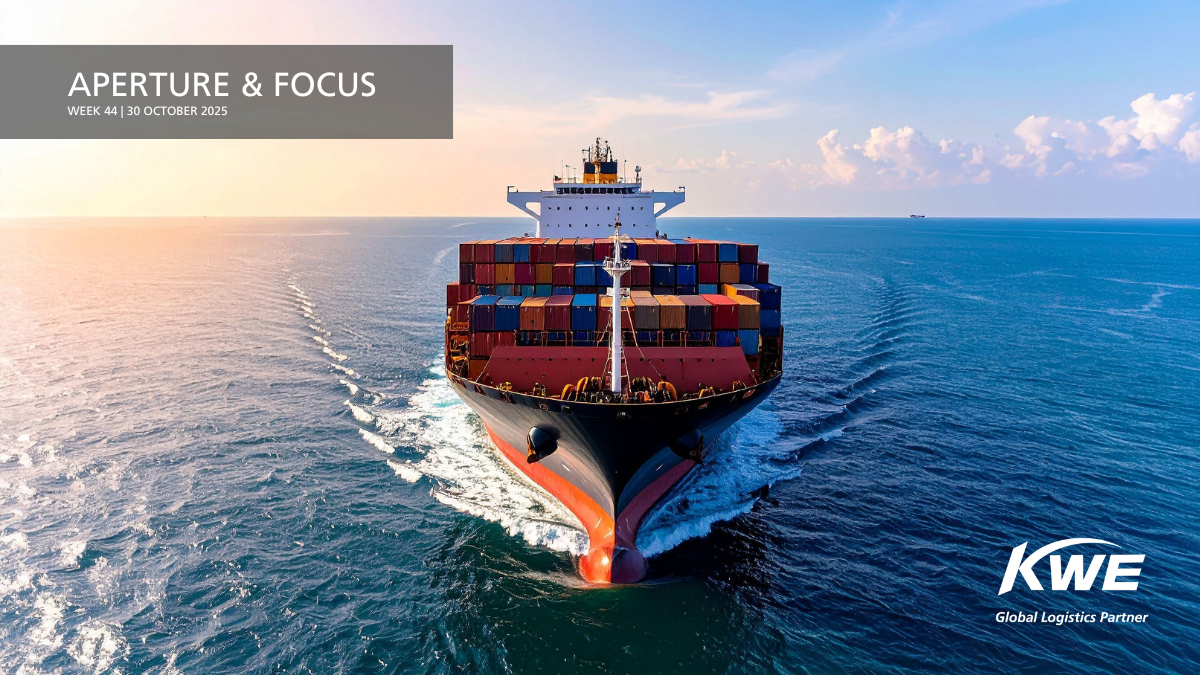Quote
Aperture & Focus 2025: Week 44

Global Aperture
Despite continued volume declines between Asia and the United States, global air cargo demand experienced its seventh consecutive month of growth in September, rising 2.9% year-on-year, according to the International Air Transport Association (IATA). The decline in transpacific traffic was offset by double-digit gains on Asia–Europe and intra-Asia routes, reflecting how shippers are adapting to new U.S. tariff policies and changing trade flows.
The United States and China have agreed to a one-year suspension of reciprocal port fees, easing tensions in the maritime sector and signaling progress in broader trade talks. The move, effective October 14, follows months of disruption as both countries imposed levies on each other’s vessels, driving up freight costs and prompting carriers to reroute ships.
Regional Focus
Americas
United States: Inbound container volumes at the ten largest U.S. ports fell 6.6% year-over-year, according to recent analysis, reversing earlier gains driven by pre-tariff frontloading. Declines are expected to intensify through 2026 as overlapping tariff measures and new U.S.–China ship fees disrupt supply chains and redirect trade to other regions.
Importers accelerated spring 2026 orders from China ahead of threatened 100% tariffs that were suspended after trade talks in Kuala Lumpur. While the rush has filled warehouses and driven record early cargo volumes, analysts warn it could leave supply chains overstocked through early 2026. As a result, many companies are expected to scale back new spring orders and slow purchasing activity in the months ahead.
Mexico: The U.S. Department of Transportation (DOT) has blocked 13 existing and proposed routes for Aeroméxico, Volaris, and VivaAerobus and moved to ban cargo carried in passenger jets from Mexico City’s main airport (MEX). The decision escalates a dispute over Mexico’s 2023 ban on all-cargo flights at Benito Juárez International Airport (MEX) and reductions in takeoff and landing slots, which the DOT says unfairly restricted U.S. carriers to the more distant Felipe Ángeles International airport (NLU). The freeze halts new U.S. routes and cargo growth from both Mexico City airports (MEX and NLU), posing disruptions for cross-border passenger and freight operations until compliance is restored.
Asia-Pacific
Malaysia, Cambodia, Thailand, and Vietnam signed new trade pacts and framework agreements with the United States during the ASEAN Summit in Malaysia, strengthening regional ties and signaling progress toward a broader truce with China. U.S. Treasury Secretary Scott Bessent said the talks produced a “substantial framework” to cancel planned 100% tariffs on Chinese imports and delay China’s rare earth export controls, pending final approval at the upcoming Trump–Xi meeting in South Korea.
Singapore: Despite global uncertainty, airfreight at Changi Airport (SIN) rose 3.7% year-on-year in the third quarter of 2025, supported by a 10% increase in imports and resilient trade flows. Top cargo markets included China, the United States, Australia, Hong Kong, and India, while new freighter services and expanded regional routes further boosted connectivity.
Hong Kong: In September, cargo volumes at Hong Kong International Airport dipped slightly due to typhoons and trade uncertainty, though demand from Europe and the Middle East remained steady. For customers, this suggests some short-term disruption in regional airfreight flows, but overall cargo activity is holding firm, signaling continued reliability in Hong Kong’s role as a key logistics hub.
Europe, Middle East & Africa
Following the recent Israel–Hamas ceasefire, a new report from market analyst Sea-Intelligence warns that a full return of container vessels to the Suez Canal could unleash major shifts in global shipping. The reopening would free up roughly 2.1 million TEU of capacity—about 6.5% of the world fleet—but could also overwhelm European ports with a surge of arrivals up to 39% above previous records. Analysts caution that without a phased transition, congestion and supply chain disruption could ripple across global trade networks.
Sweden: The Port of Gothenburg posted record container movement during the first three quarters of 2025, handling 709,000 TEUs—a 4% year-on-year increase driven by strong imports and expanded rail volumes. Over 60% of containers now move by rail, while Ro-Ro traffic is recovering and car exports have declined amid U.S. tariffs on EU vehicles.